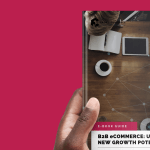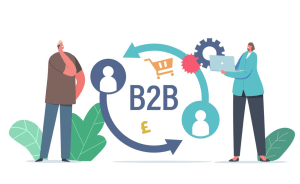Old-fashioned approaches to B2B sales models are no longer effective in the modern market. Buyers are more informed and demanding than ever before, and they expect more from their suppliers. Traditional sales models, which often rely on product features and price discounts, are no longer enough to win business. In reality, buyers often take a more nonlinear path to purchase and may engage with sales reps at different points in their journey. The future of B2B sales is expected to be hybrid, with a focus on combining in-person interactions, remote contact, and e-commerce self-service.
This shift is driven by the need to meet customer expectations for more channels and greater convenience, as well as the potential for up to 50% more revenue from hybrid sales compared to traditional models. Let’s explore this shift and take a look at the eight key steps you can take to redefine your B2B sales strategy and thrive in the new normal.
How Traditional B2B Sales Models Are Shifting And Why
The traditional B2B sales model, often characterized by cold calls, lengthy RFP processes, and siloed interactions, is undergoing a radical transformation. This shift is driven by several key factors.
1. Empowered Buyers: Today’s B2B buyers are more informed and independent than ever before. They conduct extensive research online, compare options, and are less reliant on salespeople for information. This power shift necessitates a move away from pushy tactics towards value-driven engagement and building trust.
2. Digital Transformation: The digital age has fundamentally changed how businesses operate and interact. B2B buyers expect a seamless online experience, including access to product information, self-service options, and easy communication channels. With online marketplaces offering 24/7 accessibility and advanced analytics providing deeper insights into buyer preferences, businesses are compelled to adapt their sales strategies to leverage these digital tools effectively. Traditional models structured around phone calls and in-person meetings lack the digital infrastructure to meet these expectations.
What are the key disadvantages of traditional B2B sales models?
1. High Cost
2. Slow Process
3. Limited Reach
4. Difficulty in Scaling
5. Limited Data Insights
6. Resistance to Change
7. Vulnerability to Disruptions
3. Competitive Landscape: The B2B marketplace is increasingly competitive, with global players and newcomers vying for market share. Standing out in this crowded field requires innovative approaches that emphasize agility, differentiation, and customer-centricity. By fostering a culture of innovation and adaptability, companies can remain agile and resilient in the face of uncertainty.
4. Changing Buying Habits: B2B buying journeys are becoming more complex and non-linear. Buyers engage with multiple touchpoints across departments and involve various stakeholders. Traditional models, focused on linear interactions with single decision-makers, are ill-equipped to adapt to this dynamic.
5. Demand for Personalization: In an era of mass customization and hyper-personalization, even B2B buyers expect tailored solutions that address their specific pain points and objectives. Traditional sales models, which often take a one-size-fits-all approach, aren’t well-suited to meet this demand for personalized experiences. Businesses are therefore shifting towards more agile, customer-centric approaches that leverage data analytics and predictive modeling to anticipate buyer needs and deliver customized solutions.
6. Emphasis on Relationship Building: While traditional B2B sales models focus primarily on closing transactions, modern sales approaches prioritize long-term relationship building and customer success. Businesses are recognizing the importance of fostering trust, transparency, and collaboration with their clients, rather than viewing them as mere revenue sources. By adopting a consultative selling approach and emphasizing value creation over short-term gains, companies can cultivate stronger, more resilient partnerships that drive sustainable growth.
By understanding these trends and embracing new sales approaches that prioritize customer-centricity, innovation, and flexibility, B2B businesses can position themselves for success in today’s competitive marketplace.

Find out everything you need to know about B2B e-commerce solutions for your business in our special guide
8 Steps To A More Modern B2B Sales Strategy
Now you know how B2B sales models are shifting, here are key strategies to adopt to embrace and make the most of this change.
- Choose buyer-centricity over more transactions: Moving away from transactional relationships towards customer-centric engagements is paramount in modern B2B sales. This shift entails understanding and addressing the unique needs and preferences of each client, rather than focusing solely on closing deals. By adopting a more integrated and customer-centric approach, businesses can build stronger, long-lasting relationships that drive mutual value and success.
- Embrace digital transformation: Implementing digital platforms such as sales enablement and B2B commerce platforms empowers sales teams with the tools and resources they need to succeed. These platforms streamline end-to-end sales processes, provide real-time insights, and offer buyers a seamless purchasing experience, ultimately driving growth and competitiveness.
- Personalization Beyond Buzzwords: Move beyond using “personalization” as a buzzword and genuinely tailor your approach to each client. Leveraging data analytics enables businesses to gain deep insights into customer behaviour, allowing for the creation of bespoke solutions and experiences. By delivering personalized value propositions, businesses can differentiate themselves in a crowded marketplace and forge stronger connections with clients.
- Collaborative Selling: Collaboration lies at the heart of successful B2B sales strategies. Fostering collaboration between sales teams and clients emphasizes shared goals and mutual success. Breaking down silos and encouraging cross-functional communication enables a unified approach to client satisfaction. By working collaboratively with clients, businesses can better understand their needs and deliver tailored solutions that drive tangible results.
- Agile Sales Methodology: Adopting an agile sales methodology allows businesses to respond swiftly to market changes, customer feedback, and emerging trends. By prioritizing flexibility and quick adaptation, sales teams can remain proactive and responsive, effectively navigating uncertainties and seizing opportunities as they arise.
- Technology Integration: Seamlessly integrating technology solutions into sales processes enhances efficiency and effectiveness without sacrificing the human touch. Exploring AI-driven insights, CRM systems, and collaboration platforms optimizes sales operations and improves customer engagement. By harnessing the power of technology, businesses can unlock new opportunities for growth and innovation while delivering exceptional customer experiences.
- Data-Driven Decision-Making: Data serves as a valuable resource for informed decision-making in B2B sales. Leveraging analytics enables businesses to understand market trends, customer behaviours, and sales performance, shaping strategies accordingly. By harnessing the power of data, sales teams can identify potential customers, track their progress, and measure results, driving continuous improvement and optimization.
- Education and Thought Leadership: Establishing thought leadership and providing valuable educational content to clients and prospects strengthens credibility and trust. Positioning sales teams and company leaders as trusted advisors in their industry builds meaningful relationships and enhances brand reputation. By helping clients make informed decisions, businesses can establish themselves as go-to experts, driving loyalty and long-term success in the competitive B2B market.
B2B sales are constantly changing, now more than ever. Be sure to continually be on the lookout for new tools that can help you to reach your goals, whilst keeping your customers, their feedback and their needs at the centre of your strategy.
